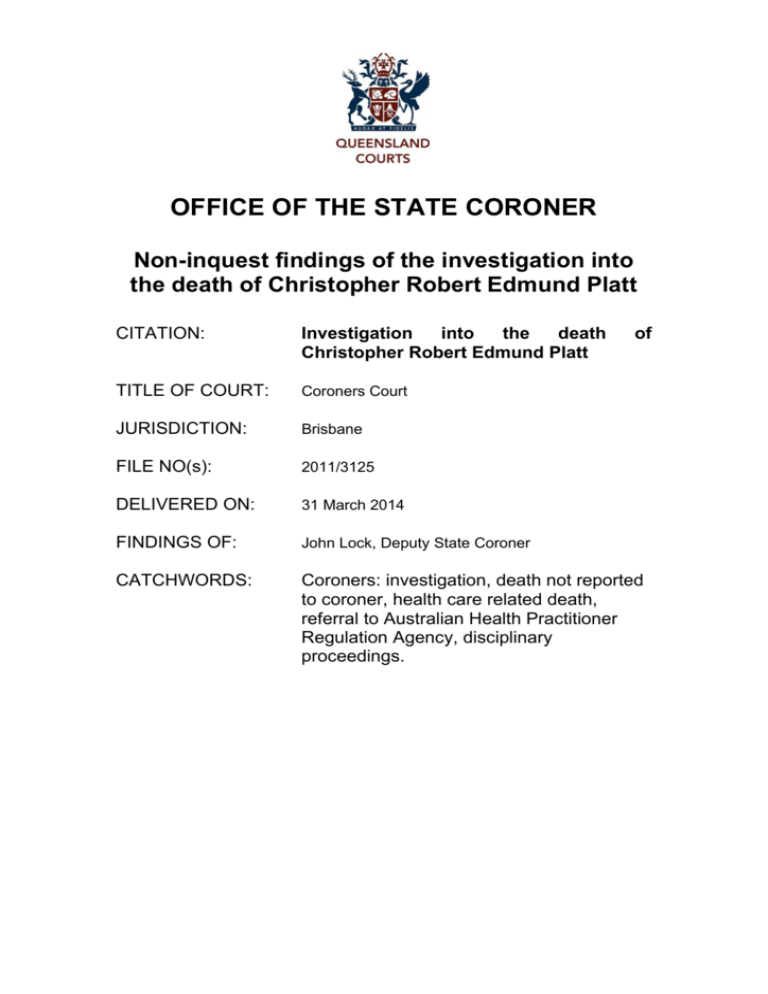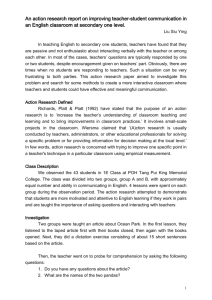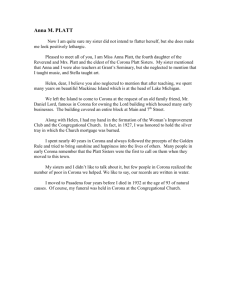Christopher Robert Edmund Platt
advertisement

OFFICE OF THE STATE CORONER Non-inquest findings of the investigation into the death of Christopher Robert Edmund Platt CITATION: Investigation into the death Christopher Robert Edmund Platt of TITLE OF COURT: Coroners Court JURISDICTION: Brisbane FILE NO(s): 2011/3125 DELIVERED ON: 31 March 2014 FINDINGS OF: John Lock, Deputy State Coroner CATCHWORDS: Coroners: investigation, death not reported to coroner, health care related death, referral to Australian Health Practitioner Regulation Agency, disciplinary proceedings. Table of Contents Table of Contents.............................................................................................1 Introduction ......................................................................................................2 Admission to Ipswich Hospital..........................................................................3 Concerns of Family...................................................................................4 Summary of Medical Treatment as Contained in Root Cause Analysis (RCA)........................................................................................................4 Opinions of the RCA Team .....................................................................10 Improvements to the services since this incident ....................................11 Lessons Learnt .......................................................................................12 Health Quality and Complaints Commission ..................................................13 Australian Health Practitioner Regulation Agency (AHPRA) Investigation.....13 Independent Expert Opinion ...................................................................13 Investigation Reports of APHRA and Decision of Victorian Board..........15 Conclusion .....................................................................................................16 Findings required by s. 45..............................................................................17 Identity of the deceased..........................................................................17 How he died............................................................................................17 Place of death.........................................................................................18 Date of death ..........................................................................................18 Cause of death .......................................................................................18 Findings of the inquest into the death of Christopher Robert Edmund Platt Page 1 Introduction Christopher Robert Edward Platt was aged 69. On 12 April 2010, he was taken by ambulance to Ipswich Hospital Emergency Department suffering a distended abdomen, incontinence and dehydration. He was diagnosed with depression and discharged. He continued to be unwell and was brought back to the hospital two days later but died the next day. A cause of death certificate was signed by Dr D. John at the hospital with the cause of death specified being a perforated bowel/septicaemia as a result of diverticulitis. His death was not reported to the Office of the State Coroner. A complaint was made by Mr Platt’s daughter to the Health Quality and Complaints Commission (HQCC) on the basis that the severity of her father's condition should have been detected at the first presentation and he should not have been discharged. On 1 September 2011, the HQCC wrote to the Brisbane Coroner advising of the death on the basis that in its view the matter constituted a reportable death. An independent clinician engaged by the HQCC was highly critical of the treatment or failure to treat at a number of levels. The HQCC also advised that it intended to consult with the Medical Board of Australia with a view to referring certain registrant doctors involved to the board. The coroner also made contact with the family and subsequently with the Ipswich General Hospital. The hospital indicated that in view of the concerns a Root Cause Analysis would be initiated. Subsequently the Australian Health Practitioner Regulation Agency (AHPRA) confirmed it was investigating the referral of a number of registrant medical practitioners. The Root Cause Analysis was completed on 28 March 2013. AHPRA completed an investigation into the performances of four medical practitioners that were involved in the care and management provided to Christopher in the Emergency Department at the Ipswich Hospital. Investigation reports were originally tabled to be heard by the Queensland Medical Interim Notifications Group but due to a lack of a quorum was referred to the Victorian Board to consider. On 5 December 2013, the Victorian Board determined it would take no further action in relation to the four doctors in the Emergency Department. This was on the basis that although it could be concluded there were shortcomings in the Emergency Department, the treatment and management provided to him was appropriate. Findings of the inquest into the death of Christopher Robert Edmund Platt Page 2 In relation to a fifth practitioner, namely a psychiatrist it was decided that no further action would be taken. All five investigations were closed. Admission to Ipswich Hospital In the early afternoon of 12 April 2010, Christopher Platt was brought into the Emergency Department of the Ipswich Hospital (the hospital) by the Queensland Ambulance Service (QAS). His family had called QAS due to concerns regarding his general deterioration, increased alcohol consumption, not eating properly, distended abdomen and incontinence. QAS required the attendance of police to convince him to go to hospital on this occasion. On arrival at the hospital at 13:04 he was triaged as category 3, which requires that patients are seen within 30 minutes. He was seen by Dr Batiya (Senior House Officer) at 14:00 hours. On examination Dr Batiya noted ongoing hiccups, abdominal distension, soft abdomen, increased bowel sounds and soft stools. The first impression was constipation and x-rays and blood tests were ordered to rule out an intestinal obstruction. The x-rays were reviewed with Dr Ifesanwo. A formal report was not available. Based on the image and the presenting condition of diarrhoea and no abdominal symptoms other than distension, the two medical officers formed the impression the diagnosis of constipation was correct. The results of blood tests were also not available at the time. Dr Batiya ordered an enema and handed over to Dr Fernandez (Principal House Officer) at the end of his shift at 15:38 hours. Dr Fernandez’s shift finished at 16:30 hours. He had other patients and had no involvement with the care and treatment provided to Mr Platt and made no entry in the patient records. Dr Ifesanwo took over the care at approximately 17:51 hours and reviewed the patient records and spoke to the patient and his family to obtain a further history. After those discussions, Dr Ifesanwo focused on Mr Platt’s mental health and documented that Mr Platt was feeling depressed, had lost interest in things he used to enjoy, had poor appetite but was not suicidal. He conducted a physical examination as well noting the result from blood tests including an elevated white cell count. A diagnosis of depression was considered. No surgical consultation was arranged. Dr Ifesanwo then consulted with his senior medical officer, Dr Bitmead, Emergency Medicine Staff Specialist. Dr Ifesanwo recalls they reviewed the X-ray and blood test results. Dr Bitmead stated he did not recall any discussion regarding the patient or undertaking an examination of the Findings of the inquest into the death of Christopher Robert Edmund Platt Page 3 patient. There is nothing documented in the patient records in relation to the nature of a discussion or any examination being conducted by Dr Bitmead. Dr Ifesanwo may have referred Mr Platt to the Adult Mental Health Service as at 20:30 hours an assessment was conducted by a mental health nurse. It was completed at 22:16 hours and shortly after there was a further assessment by the psychiatric registrar who diagnosed Mr Platt with adjustment disorder, depression and alcohol abuse. A discharge letter was sent to Mr Platt’s GP recommending that further tests including folate, B12, thyroid and liver function tests would be useful, to identify if there were other causes for the depression. He was discharged home at 23:56 hours. Dr Ifesanwo wrote a letter to the GP noting the presentation to the ED with general deterioration including high alcohol use, not eating properly, distended abdomen and incontinence. The diagnosis was depression but there was no reference to the GP for Mr Platt to have any follow-up assessment or carry out any further tests. The x-ray was formally reported on by a radiologist on 13 April 2010. The report noted the features could represent an evolving small bowel obstruction and serial x-rays may be done for further assessment. On 14 April 2010, Mr Platt re-presented to the ED and following review by the surgical team was diagnosed with diverticulitis and treated with IV antibiotics. It was considered there were insufficient signs to indicate an acute abdomen requiring immediate surgical intervention. On 15 April the abdominal symptoms and signs continued to evolve and Mr Platt was transferred to the care of the surgical team. It was decided in consultation with members of the family not to progress with surgical intervention in view of his general condition. Mr Platt died at 12:10am on 16 April 2010. The final diagnosis was thought to be perforation/septicaemia secondary to diverticulitis. Concerns of family After his death, a family member raised concerns about the assessment and treatment during his admissions to hospital. The RCA team was made aware of these concerns to ensure they would be addressed during this review. Summary of medical treatment as contained in Root Cause Analysis (RCA) Christopher had been brought to the Emergency Department by the QAS on the 12 April 2010 at 13.04. His family had called QAS due to concerns regarding his general deterioration, increased alcohol use, not eating properly, distended abdomen and incontinence. The QAS and family informed the hospital that QAS had been called to the house on a number of other occasions, however the patient refused to go to Findings of the inquest into the death of Christopher Robert Edmund Platt Page 4 hospital. On this occasion, QAS, police and the family had convinced Mr Platt to attend hospital. On arrival he was triaged as a Category 3 (Australasian Triage Scale ATS). Nursing and/or Medical assessment noted he presented with slight incontinence of faeces (loose diarrhoea noted in underwear) for two days and abdominal discomfort for last five days with occasional cramps in right inguinal fossa. It was recorded Mr Platt stated ‘he had no pain but a bit of discomfort in abdomen’. It was also recorded that he and/or family also indicated he had ‘given up’, had ceased taking regular medications, increased his smoking and drinking, and was not eating properly (however the patient was not concerned by this). Following assessment, Medical Officer A came to an impression of constipation, but needed to rule out intestinal obstruction. Blood tests and xrays were ordered along with a referral to the Hand to Home Team for review of his decline in social functioning and activities of daily living. During discussion with the family, nursing staff documented concerns by the family regarding Mr Platt’s increasing depression and poor coping, and this was handed over to the Medical Staff. From his recollection of the events during the interview, Medical Officer C recalled that following the x-ray, Medical Officer A consulted with Medical Officer C, both looked at the x-ray on the computer screen and based on the image (no report was available at this stage) it was felt at the time, given the presenting condition, history of diarrhoea and no abdominal symptoms other than the distension, the diagnosis of constipation was correct. The review of the x-ray and the subsequent decision was not documented in the patient’s medical record. Medical Officer A ordered the patient a Microlax enema on the Medication Chart. From his recollection of the events during interview, Medical Officer A could not remember reviewing the x-rays and the discussion with Medical Officer C. Also the blood test he ordered was not available to be reviewed prior to his handing over and leaving the Emergency Department. No further documentation was made in the chart by Medical Officer A, and he handed the patient over to Medical Officer B at the end of his shift 15.38. It is unknown what contact Medical Officer B had with Christopher as there is no documentation in his medical record or on the Emergency Department Information System (EDIS). In an enquiry made by Medical Officer B in response to an enquiry from APHRA, the Medical Officer stated he believed he may have only seen the patient for an hour at the end of his shift, and this may explain the lack of documentation in the patient’s clinical record. Medical Officer B no longer works for Queensland Health and therefore was not able to be contacted in relation to this review. According to the EDIS, Medical Officer B handed the patient over to Medical Officer C at 17:51. Findings of the inquest into the death of Christopher Robert Edmund Platt Page 5 Medical Officer C reviewed the notes to familiarise himself with the case and spoke to the patient and family. In addition to the information already recorded in the Medical Record by Medical Officer A, he established the patient was feeling depressed, had lost interest in things he used to enjoy, had poor appetite, his health had deteriorated and the family had expressed their inability to cope with the patient at home. The abdominal x-ray had shown no definitive bowel obstruction, however the official report was still not available at this time. Medical Officer C consulted with a Senior Medical Officer. Besides the distension there were no other concerns and it was felt his abdominal examination was unremarkable. Medical Officer C did not make any documentation regarding the abdominal x-ray as he indicated during interview that this was viewed by himself and Doctor A earlier and following discussion managed by Medical Officer A. Medical Officer C noted that only one Microlax enema had been ordered so he increased the order to two, and as a result of the following administration the patient subsequently opened his bowels. Medical Officer C reviewed the blood results and documented these, including the elevated white blood cell count. The elevated white cell count was discussed with the Senior Medical Officer and from their recollection during interview the white blood cell count was considered, however in a setting of a non acute abdomen and no definite intra-abdominal cause, no infective process or sepsis (observations stable, pain scores zero) the raised white cell count was not acted on. Medical Officer C diagnosed Mr Platt with constipation with overflow incontinence and depression (based on the initial findings of Medical Officer A and his own assessment) and this was agreed with by the Senior Medical Officer. Christopher was treated with enemas (with success) and intravenous fluid and was medically cleared. Mr Platt was then referred to the Mental Health Consultation Liaison Clinician for assessment in relation to his depression. The Mental Health Consultation Liaison Nurse reviewed Mr Platt at 20.30hrs and diagnosed him with depression and referred him to the Psychiatric Registrar for review. Mr Platt was then reviewed by the Psychiatric Registrar whose impression was he appeared unable to cope with retirement and was trying to overcome the boredom with alcohol. His poor physical health and alcohol use might have been contributing to his depressive symptoms. The Psychiatric Registrar commenced him on Thiamine (100mg mane) and counselled him and family (his wife was unhappy he was not admitted/ assessed thoroughly). A letter was sent to Mr Platt’s General Practitioner regarding the management plan including referral to a psychologist. Mr Platt was discharged home at 23.56 (as per the Emergency Department computer system EDIS). Findings of the inquest into the death of Christopher Robert Edmund Platt Page 6 The following day (13 April 2010) Mr Platt’s community care worker (Oz Care) contacted the hospital’s Hand to Home program with a complaint regarding the state in which Christopher returned home the following evening, having been incontinent. The Hand to Home coordinator reviewed his chart and contacted appropriate departments regarding the complaint and arranged a retrospective assessment screening to occur for him. The same morning a Hand to Home Service, Occupational Therapist contacted Mr Platt’s wife and completed an assessment screen over the phone. His wife was advised to bring Mr Platt back to the Emergency Department for an Older Person’s Evaluation Referral and Assessment (OPERA) review. Mr Platt was unwilling to attend that day, however he consented to present the following day (14 April 2010). He re-presented on the 14 April 2010 at 10.00hrs with family to the Emergency Department and was triaged as a Category 5 (ATS). The presenting problem was documented as ‘for Hand to Home and OPERA review – situational crisis, continual hiccups’. Mr Platt was reviewed by a Medical Officer at 10.30 who documented his worsening depression, poor mobility, poor appetite and urine & faecal incontinence. It was documented that he was in denial and that no clear history could be obtained from him apart from mild abdominal pain and constipation with some diarrhoea. According to family, Mr Platt had been deteriorating for the past six months, had become less mobile and needed a walking stick to transfer; he had difficultly mobilising to the toilet, minimal oral intake for past few weeks and he needed full assistance with activity of daily living. He had also been experiencing double incontinence. Mr Platt did admit to feeling ‘low in mood’ and was not mobilising as well, he denied having any problems and did not wish to stay in hospital. A full medical examination was undertaken and the Medical Officer documented differential diagnoses including depression, alcohol abuse, constipation and diabetes. He was to be admitted to hospital under the OPERA team and was commenced on an Alcohol Withdrawal Scale (AWS). Investigations ordered included blood tests, abdominal x-ray (to rule out small bowel obstruction), abdominal CT scan and blood glucose monitoring for diabetes. He was referred to other services including Occupational Therapy, Dietetics and Psychiatry. Mr Platt was reviewed by the Hand to Home Occupational Therapist and a Mini–Mental State Examination (MMSE) was completed with him obtaining a score of 25/30. The Occupational Therapist reported his cognition appeared intact and no areas of concern were noted, however he appeared to lack insight into his own abilities and level of functioning. It was recommended that Mr Platt be admitted as it was likely he and family would not be able to cope at home. Findings of the inquest into the death of Christopher Robert Edmund Platt Page 7 An Informant Questionnaire on Cognitive Decline in the Elderly (I.Q.C.O.D.E.) was completed by Mr Platt’s daughters resulting in a high score. The daughter’s comments included – ‘at times he appears to be in denial he is unable to care for himself in regards to toileting, showering, making a meal. He needs assistance to walk; he is forgetful and states that he has nothing wrong with him. He can be aggressive and can get stubborn. He is quite a heavy drinker and often takes medication with alcohol. He states he feels depressed and wishes he could sleep longer.’ Mr Platt was admitted to a medical ward from the Emergency Department under the OPERA team. The patient was assessed by Physiotherapy and Speech Pathology. Later in the afternoon he complained of abdominal pain (10/10), and the Medical Officer was informed. He was given Paracetamol for the pain and Diazepam (as per AWS scale) for agitation and anxiousness. The Medical Registrar reviewed him, noting a pain score of 8/10 with nausea, but no vomiting or burping. He had opened his bowels that day. Mr Platt had a slightly raised pulse and blood pressure and an extensive abdominal examination revealed a distended and tender abdomen with decreased bowel sounds, however no rebound, guarding, or rigidity. The Medical Officer made an impression of an acute abdomen; however there was no evidence of obstruction or perforation on x-ray. A diagnosis of inflammatory bowel disease was considered. The Registrar requested Intravenous fluids, medications (pain relief and an anti-emetic) and ordered the patient be nil by mouth. The Registrar discussed the patient with the Surgical Registrar, including the potential diagnosis of inflammatory bowel disease and an abdominal CT scan was planned. The same Medical Registrar saw Mr Platt one hour later due to a temperature of 37.9. Blood was taken for culture and antibiotics were ordered. Discussion occurred with the Medical Consultant. It was still noted to be an unusual picture but it was felt at this stage there was no evidence of an evolving acute abdomen (no guarding/rigidity). Further blood tests were ordered and an abdominal examination planned after the patient received pain relief to rule out a potential mass/abscess. Clinical observations (taken at 17.40) indicated Mr Platt was febrile and hypertensive and pain relief was administered and intravenous fluids commenced. He was reviewed by the Medical Registrar one hour later (late afternoon), the abdominal pain and tenderness had decreased, there was still abdominal distension, however no guarding, rigidity or palpable mass. Ongoing management included continued IV antibiotics, repeat chest x-ray, while awaiting the blood results. Following discussion with the Medical Consultant it was decided there was no need for an urgent abdominal CT scan that day and he could be managed conservatively for now. Following Mr Platt’s return from the chest x-ray, nursing staff noted he was cool, clammy and tachycardic. The Ward Call Medical Officer (Resident) was notified, oxygen applied and a blood glucose level check and ECG were Findings of the inquest into the death of Christopher Robert Edmund Platt Page 8 completed. The Ward Call Medical Officer attended and following review, requested a consultation from the Surgical Registrar. The Surgical Registrar, who had seen Mr Platt earlier attended, receiving handover from the Ward Call Medical Officer, he noted Christopher appeared unwell. A full examination was attended to. Following discussion between the Surgical Registrar and Surgical Consultant, the Consultant came in and reviewed him. It was felt that the diagnosis was possible diverticulitis; however Christopher was not for surgery at this stage. The agreed management plan was as the Surgical Registrar had documented previously but to also include regular observations of vital signs, faeces for testing, clear fluids and hourly urine measures. If his urine output was less than 30ml per hour then further fluid boluses would be required. As it was now 22.00 the team would review in the morning. At 05.30 (15 April 2010) nursing staff identified and documented an increase in his girth measurement of 2½ cm, hourly observations and urine output were attended overnight. Mr Platt either removed/refused oxygen, but saturations were maintaining at 95% on room air. The Ward Call Medical Officer was notified about the urine output and the increased girth. The Ward Call Medical Officer reviewed him within 30 minutes and noted total urine output since midnight = 70mls (6hrs), fluid boluses were given, increase in abdominal girth measurement was noted, the patient had no chest pain and was not short of breath, he did report some lower quadrant abdominal pain. The Ward Call Medical Officer spoke to the Surgical Registrar who instructed to continue fluid boluses, he would review soon. A fluid bolus 500ml was ordered and the Ward Call Medical Officer handed Mr Platt over to the day team for surgical review. The surgical team saw Mr Platt at 08.30, and it was noted he remained diaphoretic and oliguric overnight (now 30mls/hr concentrated urine). His abdomen remained sore and a decision was made to undertake an abdominal CT scan that morning. Mr Platt was transferred to the Surgical Ward. On the Surgical Ward, he was reviewed by the surgical team (11.15). On examination he was afebrile but still had a poor urine output, the abdomen was distended, however not guarded, tender L > R +++. The management plan was to continue antibiotics (triple) and intravenous fluids. The abdominal CT scan was booked for that day. At this stage the Surgical Team was working on a diagnosis of Diverticulitis, this view was supported by there being no guarding, rigidity or rebound. Nursing staff requested a review two hours later due to Mr Platt being cold and clammy and having an increased respiratory rate. He expressed no complaints, stated no chest pain/abdominal pain. On examination he was orientated, observations indicated he was afebrile, tachycardic, tachypnoea, however his chest was clear. The abdominal examination revealed a grossly distended abdomen however no tenderness, guarding or rigidity. The urine Findings of the inquest into the death of Christopher Robert Edmund Platt Page 9 output was 30mls in last hour; the case was discussed with the Surgical Registrar. The management plan was to continue intravenous fluids, hourly monitoring, await the abdominal CT scan results and notify of any concerns. During a Surgical Ward round later in the day Mr Platt was noted to be hypotensive, tachycardic, with cold peripheries and peripherally shutdown. Decreased urine output was also of concern. H i s abdomen was rigid and guarded, although he denied any pain or tenderness. An extensive discussion was held with the family regarding his condition, the family (wife and two daughters) all agreed: • • • Patient is NFR (Not for Resuscitation) Not for admission to the Intensive Care Unit Not for Surgical Intervention. It was noted that Mr Platt’s wishes were the same when well and that the patient was unwell for many weeks prior to presenting to hospital, but refused any medical intervention or medical attention. H e needed great encouragement from Oz Care, Ambulance, Police and family to present to hospital on these occasions. The family were still keen for intravenous fluids, antibiotics and analgesia. This plan was discussed with the Surgical Consultant, who agreed with the current medical management. It was documented the patient was not for the abdominal CT scan at this stage. This was due to the decision not to proceed with any surgical intervention. Christopher continued to be treated as per the management plan and was still being actively treated when he passed away a number of hours later. Opinions of the RCA Team In relation to the initial presentation, the RCA team felt the initial assessment and investigations were appropriate. Consideration was given to potential obstruction and appropriate tests ordered. In hindsight, the elevated white cell count in combination with the x-ray, distended abdomen and patient’s age could have led to further investigation of a potential evolving abdominal condition and/or sepsis. This may have led to surgical referral and admission. However, given the information recorded in the medical record and interview with the medical officers involved in this case, it was felt that they came to the diagnosis of constipation with overflow and depression based on their clinical judgement of the history from the patient, presenting symptoms and investigation results they had available to them at the time (xray report not available). Given the diagnosis of constipation with overflow the prescribing of Microlax enemas was appropriate. The results following the enema reinforced the diagnosis in the mind of the Medical Officer. At the time of assessment, the abdominal examination and subsequent x-ray (in absence of the report) was suggestive but not evident of evolving abdominal concerns. The raised white cell count was noted, however in discussions with the Senior Medical Officer, a single raised white cell count in the absence of other definitive symptoms did not raise concerns. Findings of the inquest into the death of Christopher Robert Edmund Platt Page 10 Improvements to the services since this incident These included: Increased multidisciplinary staff in the Emergency Department, Improved communication and patient identification, A rapid response to assessment including screening in the waiting room prior to admission to the department. The RCA Team believed that today; this patient would be identified early and assessed in the early stages of presentation. The RCA team had concerns regarding the clinical handover process and documentation during the initial presentation. This was to be addressed through recommendations. On the second admission, following the identification of a possible acute abdomen, the medical team continually reviewed and assessed the patient to establish a diagnosis. It was felt by the treating team that the patient was experiencing Acute Diverticulitis. At each subsequent assessment the abdomen was examined and given there was no rebound, guarding, or rigidity this led to the focus remaining on a diagnosis of Diverticulitis. It was felt that as the patient presented an unusual clinical picture in relation to signs and symptoms, the focus on Diverticulitis as a diagnosis was not an unreasonable one. The results of the chest and abdominal x-ray attended during this admission reported no free gas which ruled out a free perforation. This result would have meant the patient did not require surgical intervention; therefore it was reasonable to continue treatment with antibiotics. The medical teams continued to assess the patient and investigate and consider alternatives; however they had not reached a definitive diagnosis prior to the patient’s death. It was conceded that the ordered abdominal CT scan could have been done earlier during the second admission and this may have identified the cause of the acute abdominal symptoms, however it may not have altered the management of the patient. There were occasions where the patient’s clinical observations appeared unstable and may have clearly depicted deterioration in the patient. On each occasion the patient was reviewed by Medical Officers and teams in a timely manner. The use of the Adult Deterioration Detection System (ADDS), which is now in place throughout the Health Service, would have been an effective tool to assist both medical and nursing in early identification and response to those periods. Prior to the decline in the patient’s condition, each assessment by different treating teams presented a consistent picture. Although it is unclear what did cause the patient’s progressive distension of the abdomen, the clinical and radiological findings at the time did not support a bowel perforation or Findings of the inquest into the death of Christopher Robert Edmund Platt Page 11 obstruction. At that stage there was no clear reason to consider sepsis, peritonitis, or a deteriorating abdominal picture that would require escalation for immediate surgery or different treatment. When the patient’s condition deteriorated, the abdominal picture was now including abdominal rigidity and guarding, and the surgical team responded promptly. An extensive discussion was held with the family regarding the patient’s condition and the decision was made with the family that the patient was not for resuscitation, ICU admission or surgery. This decision appears to be in line with the patient’s own wishes prior to him becoming unwell and this was noted in the chart. A management plan was established for continued fluids, antibiotics and analgesia. This decision restricted the treating team from any other interventional treatment so the patient was managed non-surgically from this time until the patient passed away a number of hours later. Lessons Learnt Lesson Learnt 1 There was a lack of documentation that supports an effective clinical handover process between multiple staff regarding the one patient. Why is this issue important? Appropriate Clinical handover allows the timely exchange of information and allows other staff to have the most recent information regarding the patient’s clinical status, treatment plans and investigations to make informed decisions. Recommendation Number : 1 Completion of the work around ‘Clinical Handover’ for the West Moreton Hospital and Health Service. Implementation of the formal procedure and auditing program based on the National Standards. The procedure and auditing to incorporate both verbal and written (documented) handover. Development of the formal procedure to be carried out by Performance Strategy and Planning team with implementation, education and roll out by the Education Departments under Executive sponsorship of the Executive Director Medical Services/Ipswich Hospital. Lesson Learnt 2 Poor documentation at the time by all specialities. Documentation in the patient’s medical record does not routinely meet the clinical documentation standards set out in the ‘Clinical Documentation’ procedure (DWMProc201000580). Why is this issue important? Clear and concise documentation at the time of the care allows other clinicians to know the current health status and care and treatment plans for the patient in a timely manner. In incidents such as this it allows for clear understanding and ease of review. Findings of the inquest into the death of Christopher Robert Edmund Platt Page 12 Recommendation 1: Review and update the ‘Clinical Documentation’ procedure (DWMProc201000580). Upon publication, all staff are to be made aware of the updated procedure. Recommendation 2: Conduct a random chart audit to identify documentation deficiencies. Audit report to identify actions to remedy deficiencies. Report to be tabled at the Hospital and Health Service Executive Safety and Quality Meeting for endorsement. Health Quality and Complaints Commission An independent clinician provided advice to the HQCC. The clinician considered that the initial examination and assessments on admission were appropriate but the obvious results were not acted upon in a reasonable way. The medical officers who clearly saw the results missed the most important and obvious diagnosis that turned out to be fatal due to lack of basic and reasonable care. The clinician considered that the correct diagnosis was completely missed and a completely irrational diagnosis made when all the signs, symptoms and family history pointed to septicaemia probably from a bowel related cause and at 69 years of age, diverticular abscess with bowel obstruction or dead bowel must have been the top two possible diagnoses considering the history and presentation. This man was very ill and this seems to have been completely missed. The clinician considered that Mr Platt should have been admitted on 12 April 2010. When Mr Platt re-presented on 14 April 2010 although the assessments and investigations were appropriate it was too late by then. It was considered that Mr Platt would have had many problems for several days perhaps weeks prior to the ED admission on 12 April but he was sent home that day when he may have been treatable or perhaps survived. As a result of this opinion the HQCC reported the matter to the coroner and referred the matter to the AHPRA. Australian Health Practitioner Regulation Agency Investigation On 13 February 2014, AHPRA informed the coroner that it had recently completed an investigation into the performances of four practitioners that were involved in the care and management provided to Christopher in the Emergency Department at the Ipswich Hospital. Independent expert opinion AHPRA had sought an independent expert opinion from Dr Bryan Walpole, Specialist Emergency Medicine. Findings of the inquest into the death of Christopher Robert Edmund Platt Page 13 Dr Walpole opined that ED staff failed to note several important factors, and some issues leading to his inappropriate discharge have neither been addressed nor resolved. He noted that no assessment had been made of the cause for his lack of mobility, wrongly attributed to depression and alcohol. Constipation had been diagnosed, yet there is no record of his recent or past bowel usage, apart from some incontinence, and soft faeces felt on rectal examination. This was not a convincing story of constipation. He was then given two enemas and faecal flow was regarded as proof of diagnosis. In a patient with ischaemic bowel, or diverticulitis, this could be harmful, even fatal. Similarly if he is dehydrated, but it was noted he was given IV fluid. Dr Walpole considered that Mr Platt had several signs of serious illness: a persistent tachypnoea oxygen saturations between 91 – 94% white cell count was high Albumen was low irregular pulse rate. He opined that x-ray film should be reported as soon as practicable, as the film showed early small bowel obstruction suggesting ischaemic gut or diverticulitis and this would have led to immediate surgical referral and probably a CT abdomen and admission. The film was not reported until the next day and not seen until Mr Platt was readmitted on 14 April 2010. It was opined that this was a major contributor to the failure to refer and admit Mr Platt. Dr Walpole further commented: Atrial fibrillation with possible mesenteric embolus/thrombus should have been suspected; Further information should have been obtained such as smoking history, bedside ventilatory function, sputum collection and blood cultures; Alcohol abuse is assumed and thiamine prescribed without any historical or clinical support; The family was unhappy with the discharge yet there is no record of any negotiating with his wife and daughter as to why he was being discharged; Findings of the inquest into the death of Christopher Robert Edmund Platt Page 14 The number of junior doctors being supervised, the delay in x-ray reporting, the prolonged period in the ED and poor handover were also mentioned. In relation to Dr Batiya, Dr Walpole stated that given he was a junior doctor, a reasonable history was taken (with omissions) and he made a fair (but incorrect) assessment and handed over the patient after two hours. The care was reasonable and consistent with the doctor’s knowledge and skill. The treatment and management provided was appropriate. In relation to Dr Ifesanwo, Dr Walpole opined that the diagnosis of constipation was wrong and there were errors of judgement but his care was reasonable and consistent with his knowledge and skill as an intern. In relation to Dr Fernandez, Dr Walpole opined that the treatment provided was appropriate as it appeared the doctor had minimal contact with the patient and that his performance in this matter was not below the standard reasonably expected of a health practitioner of an equivalent level of training or experience. In relation to Dr Bitmead, he opined that given the several signs of serious illness that Mr Platt exhibited, a number of red flags should have noted he was a high risk patient, and none of them seem to be recognised or acted upon by Dr Bitmead, ultimately responsible for his care. He considered Dr Bitmead failed to realise the serious nature of the illness, and allowed Mr Platt to be discharged inappropriately. He opined that the treatment provided was not appropriate and the performance was below the standard reasonably expected of a health practitioner of an equivalent level of training or experience. Dr Bitmead responded and accepted the criticism and advised that a number of changes have been implemented at the ED from late 2010, that he has personally been instrumental in implementing. If Mr Platt were to present today, he would not have been discharged. It was not the policy at the hospital at the time that the ED consultant must be consulted prior to a patient being discharged but that has since changed. Dr Bitmead stated that taking into account all the information, he confirms he would have admitted Mr Platt under the medical team had he been advised that the mental health team elected to treat the patient at home on his first presentation. In retrospect and knowing what subsequently occurred, he agrees that it is possible that Mr Platt's condition was starting to evolve on 12 April 2010 when he was seen in the ED Investigation reports of AHPRA and decision of Victorian Board In relation to Drs Batiya and Fernandez, the investigation report recommended that there was insufficient evidence on which the committee could form a reasonable belief that their performance amounted to unsatisfactory professional performance. Findings of the inquest into the death of Christopher Robert Edmund Platt Page 15 This was accepted by the Victorian Board and no further action was taken. In relation to Drs Ifesanwo and Bitmead, the investigation recommended that there was sufficient evidence to form a reasonable belief that the practitioners’ performance amounted to unsatisfactory professional performance. However, the Victorian Board decided to take no further action in relation to these doctors. The committee decided this because the first practitioner involved in the care of Mr Platt ordered appropriate tests and investigations based on his assessment of Mr Platt the results of such were not available at the time that he finished his rostered shift at 15:30 hours. At that time there was no definitive treatment plan formulated. The committee had regard to test results in the patient file and the decision to discharge Mr Platt was not inappropriate. Mr Platt was appropriately assessed and his presentation was discussed with the consultant. Aside from the abnormal white blood cell count, the other test results did not indicate Mr Platt was seriously ill. Mr Platt had a background of a number of comorbidities and the test results were not enough to establish clinically that he was sufficiently acutely unwell to require admission. The committee noted that the independent opinion concluded that overall there were shortcomings in the ED however the treatment and management provided to Mr Platt was appropriate. In relation to the fifth practitioner, the psychiatric registrar, it was decided to take no further action. This was because the assessment carried out was reasonable given the history provided and there was insufficient evidence to form a reasonable belief that the practitioner’s performance amounted to unsatisfactory professional conduct. The doctor was no longer a registered health practitioner. Conclusion Mr Platt was an unwell man, with a background of a number of comorbidities complicated by reluctance to seek medical help at times. He was taken to Ipswich Hospital on 12 April 2010 in an unwell condition. It is apparent that there were shortcomings in the Emergency Department and in particular medical staff failed to note several important factors which led to his inappropriate discharge. An RCA concluded in hindsight, the elevated white cell count in combination with the x-ray, distended abdomen and patient’s age could have led to further Findings of the inquest into the death of Christopher Robert Edmund Platt Page 16 investigation of a potential evolving abdominal condition and/or sepsis. This may have led to surgical referral and admission. The RCA Team believed that today; this patient would be identified early and assessed in the early stages of presentation. The RCA team had concerns regarding the clinical handover process and documentation during the initial presentation. This was addressed through recommendations. The clinical issues identified by the HQCC have been investigated by AHPRA. Notwithstanding adverse findings in relation to the care provided and with recommendations that two medical practitioners’ performance should be considered unsatisfactory professional performance, a decision was made that no further action was warranted. A finding as to how, and in what circumstances Mr Platt died can be made. Recommendations have been considered in the course of an RCA to help prevent deaths from similar causes occurring in the future. Any referral of medical practitioners to a disciplinary body has already occurred as a result of the referral by the HQCC and that has been enquired into and a decision has been made as to what steps should be taken. In those circumstances the holding of an inquest will not advance any of those matters further. However, this case is one where I consider it is appropriate to publish the findings although no inquest has been held, pursuant to section 46A of the Coroners Act, on the basis that it is in the public interest. Mr Platt’s family have consented to this course of action. Findings required by s. 45 Identity of the deceased – Christopher Robert Edmund Platt How he died – Christopher Robert Edward Platt was aged 69. On 12 April 2010 he was taken by ambulance to Ipswich Hospital Emergency Department suffering a distended abdomen, incontinence and dehydration. He was diagnosed with depression and discharged. He continued to be unwell and was brought back to the hospital two days later but died the next day. Investigations should have been made, which would have detected early small bowel obstruction suggesting ischaemic gut or diverticulitis and this should have led to immediate surgical referral and probably a CT abdomen and admission. This Findings of the inquest into the death of Christopher Robert Edmund Platt Page 17 may have resulted in a better outcome. When he re-presented two days later he was very unwell and although he received appropriate treatment he died. Place of death – Ipswich Hospital Chelmsford Avenue Ipswich Queensland Date of death– 16 April 2010 Cause of death – Perforated bowel/septicaemia as a result of diverticulitis. I close the investigation. John Lock Deputy State Coroner Brisbane 31 March 2014 Findings of the inquest into the death of Christopher Robert Edmund Platt Page 18






